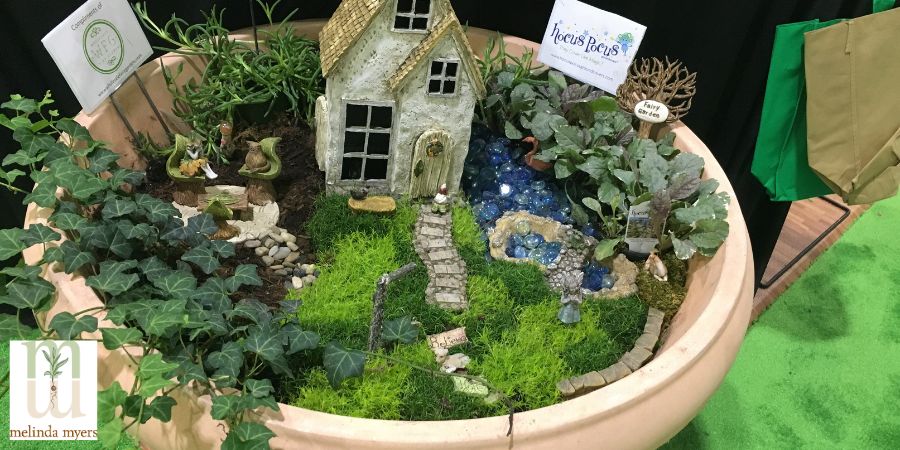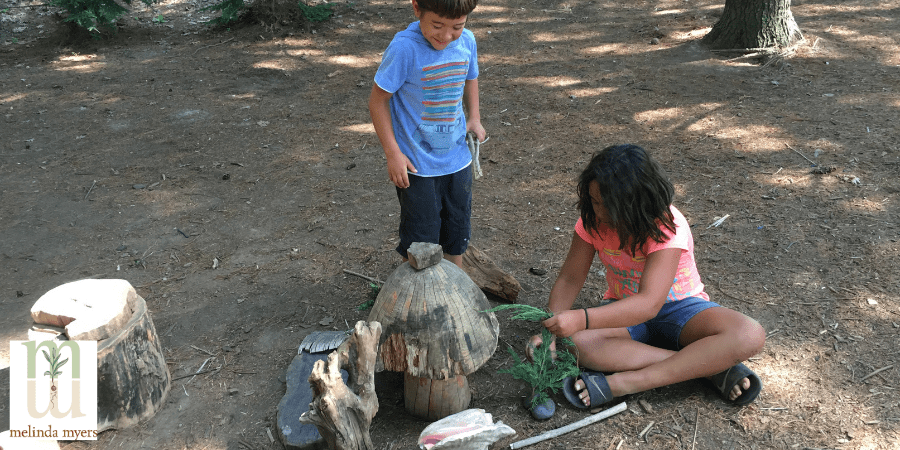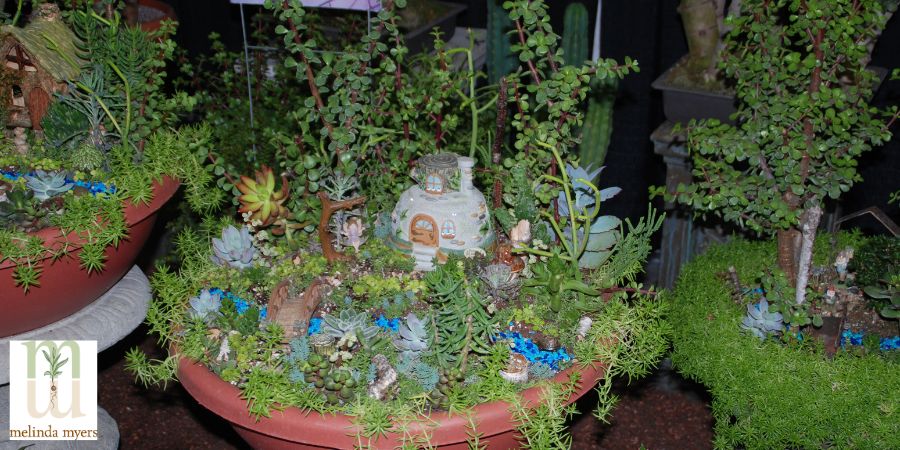How to Make a Backyard Fairy Garden
- horticulturist and gardening expertJune 1, 2024
Magical and whimsical miniature gardens hidden among full sized plants is the best description I found for fairy gardens. Like some of you I thought fairy gardens were just small-scale gardens filled with miniature plants and accessories. I also thought it was a trend that was no longer popular. While preparing for this blog I learned a lot about its popularity and the many interpretations for what constitutes a fairy garden.
Author and miniature gardening expert Janet Calvo shares, “Fairy gardens are created specifically for fairies with whimsical houses, fantastical furniture, and a fairy figure or two are hidden among the regular-sized garden plants and herbs.”

Many fairy gardeners talk about what fairies like and what you should include based on the fairies’ passions, likes, and dislikes. They list specific plants, although this list varies by author and garden center. Most include sparkly items and gifts like buttons, ribbons, nut shells for boats, and similar items to attract fairies to the garden. Showing you share concern for nature is also said to help you earn the trust of the fairies so they will visit your garden.
No wonder there are so many different types of fairy gardens and accessories for sale. In Janet Calvo’s blog Re-Defining the Miniature Garden and Creating History she shared her thoughts about what fairies want in their gardens. “There is no solid evidence, only random choice and no concrete reason or system on how/why/where fairies live, but we do know fairies exist in almost every country’s history. So, to pretend that anyone knows exactly what a fairy needs is equivalent to saying you know what goes through the mind of a fly. It was up to the personal whim of the author, advising you to wear your clothing inside out to ward off evil spirits or make sure your fairies have a bicycle… (arg! they have wings! why do they need bicycles??)”
After reading lots of opinions on what makes a fairy garden, I was reminded of a garden talk I heard years ago by Tovah Martin, where she talked about infusing your personality into your garden and not really allowing other’s opinions to influence your choices. I am not sure this was the title, but my takeaway was “It’s my Garden & I Don’t Care What You Think”. So perhaps the best option is to create the garden that you believe will best suit the fairies.
As you create your fairy garden you may find the following tips helpful:
Not Just for Kids
As you chat with fairy gardeners and follow their posts you will find the majority are adults. I must admit I created “fairy gardens” with two of my grandkids a few years ago. We visited Bookworm Gardens in Sheboygan, WI where the gardens provided a space for kids to build fairy garden areas in an opening in the woods. There were sticks, stones, branches, shells, and cones left in the space for the kids to create their version of a fairy garden. My grandkids had a wonderful time and couldn’t wait to do the same thing in one of my gardens. They picked a spot in the shade of my magnolia, looked for items in the shed and started creating. Once complete my grandson asked me to never disassemble the garden. An avid fairy gardener would probably take exception to their oversized fairy village, but I was excited because it kept them outside and engaged in nature. So for me that was a winning fairy garden.
You might be looking for something a bit more in keeping with what you are seeing on Pinterest and Instagram. Selecting the location, plants and accessories can be fun and a very personal decision.
Where to Build Your Fairy Garden
Most fairy gardeners agree that fairies are considered guardians of nature and prefer to live in more natural spaces. Placing your fairy garden in an area between a tended and untended space perhaps under a tree, near a meadow or similar location is the best spot to attract the fairies.
Many fairy gardens are built in containers, wheelbarrows, found items, or anything that can hold soil, plants, and fairy garden accessories. Place these in an area where you can visit and enjoy what you create and if you are trying to please the fairies many recommend placing them in an area with dappled shade. But once again, remember you are creating a garden for both you and the fairies to enjoy.

Assembling a Fairy Garden
How to Attract Fairies
A common theme is that fairies are distrustful of people because we do not respect the land, wildlife, and nature. Showing you care by recycling, composting, and gardening organically can help you win their trust. Whether you believe this or not, these are all good things we can do to create a beautiful and productive garden while being kind to the environment.
Many fairy gardeners include trinkets and gifts for the fairies to encourage a visit or thank them for moving in. Besides being shiny many believe they should be useful. A nutshell can be used as a boat to cross water while flower nectar, flower buds, dew, fruits, bread, pies, and honey are said to be among their favorite foods. Keep in mind honey and some of the other recommended food might also attract ants to the gardens. I’ll stick with the flowers and dew for mine.
Include a bit of water for bathing and play. A large seashell, saucer of water or fairy garden pond make nice water features. Water will also help attract some of the fairies’ favorite playmates like ladybugs, dragonflies, and butterflies. Add some sound with nearby chimes and fragrant plants to please these visitors.
Plants for Your Fairy Garden
Of course, you will want to include a few plants. I was surprised to see larger plants like sunflowers, snapdragons, poppies, and foxgloves recommended. These create a nice environment for the smaller scale fairy garden nestled inside the planting. Select for small scale and slow growing plants to include within the fairies’ yard and garden. These can be used to create a landscape in scale with visiting fairies. You will find a wide selection of suitable plants at most garden centers and online nurseries.
Select plants that are rated hardy to your area and will survive the winter when creating a fairy garden meant to last for years. Make sure the plants are suited to the growing conditions including soil, sunlight, and summer heat.
Creeping thyme is an excellent choice for sunny areas with well-drained soil. Creeping veronica and low growing sedums are other low growing possibilities. Purchase small plants of dwarf conifers to use a shrubs and trees in the garden. These are slow growers adding texture and year-round foliage for you and the fairies to enjoy. Just wander through the garden center and check the tags for the mature height and preferred growing conditions of the small-scale plants you like.
Cacti and succulents are also a popular choice as they are readily available and come in a variety of sizes and shapes. Tropical plants like fine-leaved pilea, baby’s tears, ferns and small palms are excellent for partially shaded spots outdoors. Plant these in containers so you can move your garden indoors for winter if the plants are not hardy in your region. Or plan on replacing them next spring.

Designing the Fairy Garden
You can find lots of fairy garden designs online or let your imagination be your guide. Arrange the plants to create a pleasing landscape you think your fairies will prefer. Use stones to create paths to a fairy house you purchase or create. Use twigs to build a fence, a swing for fun, and a bench for relaxing.
Caring for Your Fairy Garden
Just like any garden you will need to make sure the plants receive the care they need to thrive. Water new plantings often enough to keep the roots moist. Gradually extend the time between watering to encourage a more robust root system.
Check the soil every day for fairy gardens growing in a pot. Tropical plants prefer moist well-drained soil and most flowers also benefit from regular watering. Cacti and succulents need a fast-draining soil and need to be watered only when the top few inches of soil are dry.
Avoid over fertilizing your fairy garden. Too much and fast release fertilizer can stimulate excess growth that you will need to prune or replace the plant with a smaller specimen. Milorganite’s low nitrogen slow-release fertilizer will provide weeks of nutrients without encouraging excess growth. Incorporate it into the top couple inches of soil before planting.
Most Importantly- Have Fun
Every hobby has experts and those making recommendations on the right or best way to participate in the activity. The same is true for fairy gardening. We can learn a lot from each other but also from planting and tending our own fairy garden. Like any type of gardening, it is a mix of art and science that provides us with an opportunity to express our creativity. Use fairy gardening as a form of gardening to do just that.

